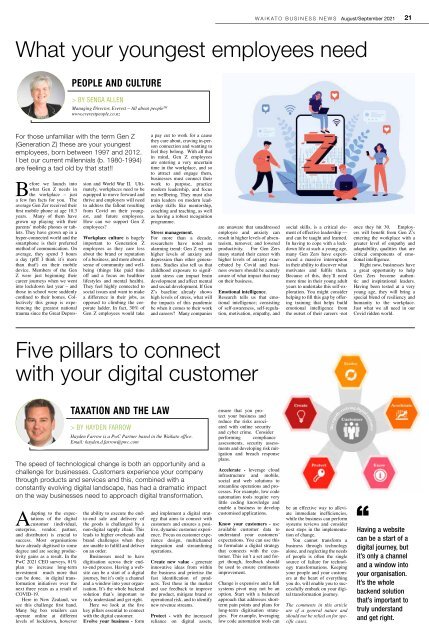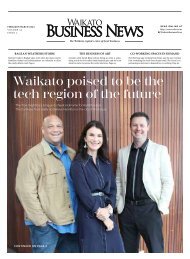Waikato Business News August/September 2021
Waikato Business News has for a quarter of a century been the voice of the region’s business community, a business community with a very real commitment to innovation and an ethos of co-operation.
Waikato Business News has for a quarter of a century been the voice of the region’s business community, a business community with a very real commitment to innovation and an ethos of co-operation.
You also want an ePaper? Increase the reach of your titles
YUMPU automatically turns print PDFs into web optimized ePapers that Google loves.
WAIKATO BUSINESS NEWS <strong>August</strong>/<strong>September</strong> <strong>2021</strong><br />
21<br />
What your youngest employees need<br />
PEOPLE AND CULTURE<br />
> BY SENGA ALLEN<br />
Managing Director, Everest – All about people TM<br />
www.everestpeople.co.nz<br />
For those unfamiliar with the term Gen Z<br />
(Generation Z) these are your youngest<br />
employees, born between 1997 and 2012.<br />
I bet our current millennials (b. 1980-1994)<br />
are feeling a tad old by that stat!!<br />
Before we launch into<br />
what Gen Z needs in<br />
the workplace – just<br />
a few fun facts for you. The<br />
average Gen Zer received their<br />
first mobile phone at age 10.3<br />
years. Many of them have<br />
grown up playing with their<br />
parents’ mobile phones or tablets.<br />
They have grown up in a<br />
hyper-connected world and the<br />
smartphone is their preferred<br />
method of communication. On<br />
average, they spend 3 hours<br />
a day (pfff I think it’s more<br />
than that!) on their mobile<br />
device. Members of the Gen<br />
Z were just beginning their<br />
career journeys when we went<br />
into lockdown last year – and<br />
those in school were suddenly<br />
confined to their homes. Collectively<br />
this group is experiencing<br />
the greatest national<br />
trauma since the Great Depression<br />
and World War II. Ultimately,<br />
workplaces need to be<br />
equipped to move forward and<br />
thrive and employers will need<br />
to address the fallout resulting<br />
from Covid on their youngest,<br />
and future employees.<br />
How can we support Gen Z<br />
employees?<br />
Workplace culture is hugely<br />
important to Generation Z<br />
employees as they care less<br />
about the brand or reputation<br />
of a business, and more about a<br />
sense of community and wellbeing<br />
(things like paid time<br />
off and a focus on healthier<br />
lifestyles and mental health).<br />
They feel highly connected to<br />
social issues and want to make<br />
a difference in their jobs, as<br />
opposed to climbing the corporate<br />
ladder. In fact, 30% of<br />
Gen Z employees would take<br />
a pay cut to work for a cause<br />
they care about, craving in-person<br />
connection and wanting to<br />
feel they belong. With all that<br />
in mind, Gen Z employees<br />
are entering a very uncertain<br />
time in the workplace, and so<br />
to attract and engage them,<br />
businesses must connect their<br />
work to purpose, practice<br />
modern leadership, and focus<br />
on wellbeing. They must also<br />
train leaders on modern leadership<br />
skills like mentorship,<br />
coaching and teaching, as well<br />
as having a robust recognition<br />
programme.<br />
Stress management.<br />
For more than a decade,<br />
researchers have noted an<br />
alarming trend: Gen Z reports<br />
higher levels of anxiety and<br />
depression than other generations.<br />
Studies also tell us that<br />
childhood exposure to significant<br />
stress can impact brain<br />
development and affect mental<br />
and social development. If Gen<br />
Z’s baseline already shows<br />
high levels of stress, what will<br />
the impacts of this pandemic<br />
be when it comes to their work<br />
and careers? Many companies<br />
are unaware that unaddressed<br />
employee and anxiety can<br />
result in higher levels of absenteeism,<br />
turnover, and lowered<br />
productivity. For Gen Zers<br />
many started their career with<br />
higher levels of anxiety exacerbated<br />
by Covid and business<br />
owners should be acutely<br />
aware of what impact that may<br />
on their business.<br />
Emotional intelligence.<br />
Research tells us that emotional<br />
intelligence; consisting<br />
of self-awareness, self-regulation,<br />
motivation, empathy, and<br />
social skills, is a critical element<br />
of effective leadership —<br />
and can be taught and learned.<br />
In having to cope with a lockdown<br />
life at such a young age,<br />
many Gen Zers have experienced<br />
a massive interruption<br />
in their ability to discover what<br />
motivates and fulfils them.<br />
Because of this, they’ll need<br />
more time in their young adult<br />
years to undertake this self-exploration.<br />
You might consider<br />
helping to fill this gap by offering<br />
training that helps build<br />
emotional intelligence from<br />
the outset of their careers -not<br />
once they hit 30. Employers<br />
will benefit from Gen Z’s<br />
entering the workplace with a<br />
greater level of empathy and<br />
adaptability, qualities that are<br />
critical components of emotional<br />
intelligence.<br />
Right now, businesses have<br />
a great opportunity to help<br />
Gen Zers become authentic<br />
and inspirational leaders.<br />
Having been tested at a very<br />
young age, they will bring a<br />
special blend of resiliency and<br />
humanity to the workplace.<br />
Just what we all need in our<br />
Covid ridden world.<br />
Five pillars to connect<br />
with your digital customer<br />
TAXATION AND THE LAW<br />
> BY HAYDEN FARROW<br />
Hayden Farrow is a PwC Partner based in the <strong>Waikato</strong> office.<br />
Email: hayden.d.farrow@pwc.com<br />
The speed of technological change is both an opportunity and a<br />
challenge for businesses. Customers experience your company<br />
through products and services and this, combined with a<br />
constantly evolving digital landscape, has had a dramatic impact<br />
on the way businesses need to approach digital transformation.<br />
Adapting to the expectations<br />
of the digital<br />
customer (individual,<br />
enterprise, vendor, partner,<br />
and distributor) is crucial to<br />
success. Most organisations<br />
have already digitised to some<br />
degree and are seeing productivity<br />
gains as a result. In the<br />
PwC <strong>2021</strong> CEO surveys, 81%<br />
plan to increase long-term<br />
investment much more that<br />
can be done. in digital transformation<br />
initiatives over the<br />
next three years as a result of<br />
COVID-19.<br />
Here in New Zealand, we<br />
see this challenge first hand.<br />
Many big box retailers can<br />
operate online at different<br />
levels of lockdown, however<br />
the ability to execute the endto-end<br />
sale and delivery of<br />
the goods is challenged by a<br />
non-digital supply chain. This<br />
leads to higher overheads and<br />
brand challenges when they<br />
are unable to fulfill and deliver<br />
on an order.<br />
<strong>Business</strong>es need to have<br />
digitisation across their endto-end<br />
process. Having a website<br />
can be a start of a digital<br />
journey, but it’s only a channel<br />
and a window into your organisation.<br />
It’s the whole backend<br />
solution that’s important to<br />
truly understand and get right.<br />
Here we look at the five<br />
key pillars essential to connect<br />
with the digital customer.<br />
Evolve your business - form<br />
and implement a digital strategy<br />
that aims to connect with<br />
customers and ensures a positive,<br />
dynamic customer experience.<br />
Focus on customer experience<br />
design, multichannel<br />
integration and streamlining<br />
operations.<br />
Create new value - generate<br />
innovative ideas from within<br />
the business and priortise the<br />
fast identification of products.<br />
Test these in the market<br />
and use feedback to improve<br />
the product, mitigate brand or<br />
operational risk, and to identify<br />
new revenue streams.<br />
Protect - with the increased<br />
reliance on digital assets,<br />
ensure that you protect<br />
your business and<br />
reduce the risks associated<br />
with online security<br />
and cyber crime. Consider<br />
performing compliance<br />
assessments, security assessments<br />
and developing risk mitigation<br />
and breach response<br />
plans.<br />
Accelerate - leverage cloud<br />
infrastructure and mobile,<br />
social and web solutions to<br />
streamline operations and processes.<br />
For example, low code<br />
automation tools require very<br />
little coding knowledge and<br />
enable a business to develop<br />
customised applications.<br />
Know your customers - use<br />
available customer data to<br />
understand your customers’<br />
expectations. You can use this<br />
to formulate a digital strategy<br />
that connects with the customer.<br />
This isn’t a set and forget<br />
though, feedback should<br />
be used to ensure continuous<br />
improvement.<br />
Change is expensive and a full<br />
systems pivot may not be an<br />
option. Start with a balanced<br />
approach that addresses shortterm<br />
pain points and plans for<br />
long-term digitisation strategies.<br />
For example, leveraging<br />
low code automation tools can<br />
Th<br />
be an effective way to alleviate<br />
immediate inefficiencies,<br />
while the business can perform<br />
systems reviews and consider<br />
next steps in the implementation<br />
of change.<br />
You cannot transform a<br />
business through technology<br />
alone, and neglecting the needs<br />
of people is often the single<br />
source of failure for technology<br />
transformations. Keeping<br />
your people and your customers<br />
at the heart of everything<br />
you do, will enable you to successfully<br />
embark on your digital<br />
transformation journey.<br />
The comments in this article<br />
are of a general nature and<br />
should not be relied on for specific<br />
cases.<br />
e rapidly evolving digital customer<br />
Having a website<br />
can be a start of a<br />
digital journey, but<br />
it’s only a channel<br />
and a window into<br />
your organisation.<br />
It’s the whole<br />
backend solution<br />
that’s important to<br />
truly understand<br />
and get right.


















